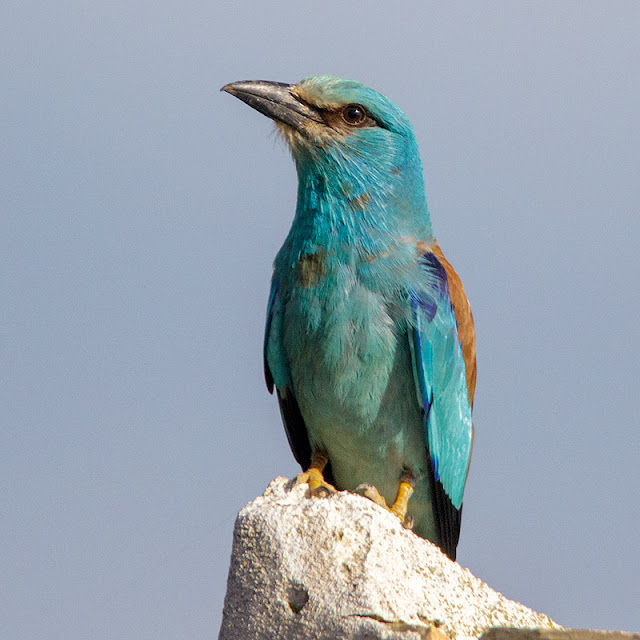My review,
Canon EOS 30D from 2006
So I purchased this Canon camera from eBay, in 2021 and due to COVID-19 restrictions, I didn't travel back to the UK. So now the camera is back here in Spain, I've used the 30d almost all of the time during the spring migration of 2022. Although the Canon 7d Mk 1 is still my favourite.
Purchased for €25.00.+ £5.00 p+p. From ebay. In 2006 EOS 30D body cost £1,399 mine is in mint condition with a battery grip and shutter count of 5614, and I was assured by the seller the shutter count has never been reset. Shutter's life expectancy is 100,000. 5 frames a second, Spot Metering, high iso, and low ISO down to 100 and clear of noise. This was one of Canon's high-end semi-pro cameras from that time.
To be honest I've mostly indulged and purchased all the latest Canon Cameras and now with everyone wanting Mirrorless Cameras, the bottom has dropped out of DSLR secondhand market, with loads of bargains to be had.
Canon 30D
Image from Canon WebSite
Do these images still stand up, for this sixteen-year-old camera you judge for yourself in 2022?
I seem to be going backwards in time and I prefer the older Canon cameras with smaller pixel counts the 30D is only an 8.2-megapixel sensor but it is the size of the pixel and the density of the pixel that I think makes a difference Canon EOS 30D counts 2.43 MP/cm² compared with my Canon 760D (2015) which has a pixel density of 7.3 MP/cm²
 |
| European Roller |
what does this mean in real terms, more pixels squeezed in the APS sensor can produce bigger prints but more digital noise. But the improvement of the in-camera noise reduction software does reduce grainy camera noise? The main improvement I think is in ISO being able to take images in almost total darkness. But in reality how many photographers are doing this? but I like this feature.
 |
| Blue rock Thrush |
See the graft below about pixel size
The short answer is yes, more pixels should produce sharper images and more resolution, but in practice and the real world, it's hard to notice.
 |
| Brimstone Butterfly |
Sharpness has two components - resolution (fine detail) and contrast (how those details are seen). Of the two, contrast contributes most to our visual perception of sharpness once resolution reaches a fairly modest level (and easily exceeded by most cameras these days). For example, when you apply sharpening to an image, it doesn't improve resolution but increases edge contrast around details so they're more clearly visible - and the result can be dramatic.
 |
| Orphean Warbler |
Image ‘sharpness’ is subject to lens quality, pixel density, and sensor size. In theory, the full frame should be better than APS. Recent APS sensors are claimed to be as good as a full-frame.
Last but certainly no means least it's the kind of light you're working in. Hard light casts stronger shadows and naturally increases contrast and the emphasis on detail (bright sun, direct flash) whereas soft light on an overcast day flattens contrast and softens perceived detail. When using long lenses at a distance, atmospheric pollution or heat shimmer can also reduce contrast substantially, like shooting through a fog.
 |
| Black Wheatear |
There is a gap of 9 years between
Canon 30D (2006) and Canon 760D (2015). Nine years is a lot of time in terms of technology, meaning newer sensors are overall much more efficient than the older ones.
But here's the big question can you tell the difference? All images are taken in Canon RAW and processed with Adobe Camera RAW, with minimal adjustments and corrections, everything is done in manual mode, with no auto adjustment. And no tricks.
Have a look for yourself, any decent Canon Camera and Canon L lens may produce high-quality images and fine resolution with good Canon glass.
 |
| Trumpeter Finch |
The lens I almost used was a Canon 600f4 with a Canon 1.4 converter and sometimes a Canon DO 400 f4 L lens with a converter.
The Beast
I'm always cropping from the centre maybe if I was cropping from an edge it might be different Story, upload images are prepared to a small image file size of less than 150kb so there's a big loss of image detail and quality when I upload to Blogger. The blogger software compresses it even more and takes away even subtle details.
Make your mind
conclusion and images
 |
| Whinchat |
I still struggle to see any major difference between images, in the real world. As long as it looks sharp on the screen on the back of the camera. it will be fine on the computer as the resolution on the Canon 30d screen is poor and lacks colour, pixels, and contrast, but other than that I can live with it, I just check the histogram And correct it in post.
So is the Canon 30d worth £25.00 and any of the older generation EOS Cameras in good condition
Well a massive yes for £25.00 is a no-brainer
 |
| Sardinian Warbler |
Grab yourself a bargain you won't regret it.
Any of the semi-pro Canon cameras or the out-of-date professional cameras will do the job just fine. if like me Andy publish images for the web, the difference is undetectable.
 |
| Stone Curlew |
Save yourself a few grand and go on a birding holiday
And make some news
And go birding.
 |
| Melodious Warbler |
hope you enjoyed the article
some of these photos have already been publishing the blog.
 |
| Bonelli's Eagle |
Today the Pallid Swifts have moved on and gone south.
Winters Coming.

.jpeg)


No comments:
Post a Comment